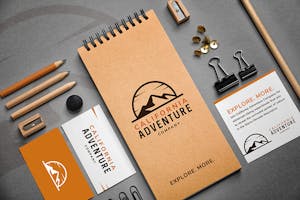- 5 minute read
- Business Management Tips
- Dashboard & FareHarbor
- Reputation Management
From Clicks to Check-In: Mastering the Art of Positive First Impressions
Intermediate
Spark is headed to the Big Easy! Join us in New Orleans October 13-15. Registration opens soon!

Your brand is one of the most powerful tools in your marketing arsenal as it represents your identity as a business and the quality of the services you provide, at-a-glance. Taking the time to create clear, memorable branding will enable your company’s personality to shine through your website, social media accounts, and all channels of communication to attract qualified customers to engage with your business.
Branding encompasses everything from logos, colors, and fonts to photography, writing style, and beyond. Developing impactful, consistent components of your brand will build trust and recognition with customers and showcase your business as a valuable option for those looking to book tours and activities.
This guide covers important elements to consider when thinking about how to build your brand. Once you have an understanding of the basics, head over to our brand building and web branding checklists to evaluate your progress and grow your skills.
Ensuring that your company is well-branded may require you to dedicate valuable time, energy, and even money to create a recognizable look and feel. However, having a brand that truly resonates with customers will be well worth the effort in the end.
Branding is key to establishing trust with potential customers and partners. When new customers come into contact with your company, no matter how good you are at what you do, they will make snap judgments based on what they see. The reality is that you have mere moments to make a good impression. Good branding effectively conveys that you are a legitimate company, worthy of their business.
When someone first visits your website, for example, having an informative or unique company name, a logo that looks clean and professional, and clear, easily-digestible information about your service offerings can be the difference between getting bookings and not.
 Beyond appearing as a reputable and trustworthy operation, consistent branding will help customers recognize various pieces of communication in association with your company. On a daily basis, the average consumer is bombarded with emails, ads, social media posts, and more from hundreds of companies. How will your company cut through the noise?
Beyond appearing as a reputable and trustworthy operation, consistent branding will help customers recognize various pieces of communication in association with your company. On a daily basis, the average consumer is bombarded with emails, ads, social media posts, and more from hundreds of companies. How will your company cut through the noise?
Consistent use of your logo, colors, fonts, and even the tone in which you write emails and social media captions will reinforce your brand’s identity so that no matter where or when the communication hits customers, it’s clear that it’s coming from YOU.
In a sea of competitors, why should someone pick you over the operator down the street? Branding helps communicate who you are, what you do, and why people should choose you in a clear, concise manner. Simply put, setting standards for your branding will allow you to stand out from your competition for all the right reasons, resulting in more bookings.
When you think of branding, you might first think of a company’s name or logo. While those are important brand elements, you should think of your brand as the overall experience someone associates with your company.
 Pro-tip: Ask yourself: What do you want people to feel when they engage with your brand? Inspired? Excited? Adventurous? Relaxed?
Pro-tip: Ask yourself: What do you want people to feel when they engage with your brand? Inspired? Excited? Adventurous? Relaxed?
Before you start to design a logo or even select brand colors, it’s helpful to take the time to set a basis for who you are as a company, your goals, and what you stand for. Rooting all brand elements in this foundation will create a thoughtful, consistent, purpose-driven brand experience for your customers.
 What do you do? This may seem like a simple question, but sometimes it can be a challenge to distill a wide range of service offerings into a quick, easily-digestible statement. Try to keep things as straightforward as possible without being too vague. Whether it’s in the format of a tagline or intro text on your website, someone who is completely unfamiliar with your business should be able to understand what your company does almost immediately.
What do you do? This may seem like a simple question, but sometimes it can be a challenge to distill a wide range of service offerings into a quick, easily-digestible statement. Try to keep things as straightforward as possible without being too vague. Whether it’s in the format of a tagline or intro text on your website, someone who is completely unfamiliar with your business should be able to understand what your company does almost immediately.
Why do you do it? Slightly different than your core service offerings, the background of how you got started or what your company hopes to achieve by existing will add to the narrative of your brand. This “why” can further differentiate you from your competition and give customers a sense for the passion or commitment you have for your business, your community, and your customers.
Who are you trying to attract? Knowing your target audience is a key element of effective branding. Think about who is most likely to be interested in your service offerings and then try to include messaging, images, colors, and other relevant information to attract that group. Once you’ve identified your audiences, you can tailor various brand elements to further appeal to their specific demographics.
Why should someone pick YOU? Beyond the basics of what you do and who might be interested, it’s important to build points of differentiation into your brand. It could be your scenic location, the fact that you’ve been doing it for generations, that your tours and activities are great for families, or anything under the sun that makes you unique. Every company has something different to offer, so taking a moment to think about the qualities that set you apart from the rest will help you craft visuals and messaging to take potential customers from looking to booking.
Once you have a better idea of your story, your audience, and what makes you unique, you can start to build an arsenal of brand elements that will support the foundation you set. Use this groundwork to determine how your brand should “feel” to an external audience and then create the following components with the goal of eliciting that same experience.
Any branding elements that support how your brand looks are components of your visual identity. These elements build brand recognition and help customers identify your company quickly and easily.
As the “face” of your company, your logo should communicate the name of your company and communicate a sense of what your business is all about.

By selecting a few core brand colors and using them consistently, color can prove to be a powerful reinforcement of your brand.
 Have intention. Take a look at the brand colors of similar companies or your direct competition and try to be different in your color choices. Why get lost in the mix when you can stand out? It’s also helpful to think about what you want to say with color. Do your activities involve the outdoors? Shades found in nature may complement what you do, although, it doesn’t have to be so literal. Do you offer walking tours that venture off the beaten path? Maybe a bright pop of hot pink conveys a sense of adventure. No matter what colors you pick, always have reasoning behind your choices so that they echo your brand’s purpose.
Have intention. Take a look at the brand colors of similar companies or your direct competition and try to be different in your color choices. Why get lost in the mix when you can stand out? It’s also helpful to think about what you want to say with color. Do your activities involve the outdoors? Shades found in nature may complement what you do, although, it doesn’t have to be so literal. Do you offer walking tours that venture off the beaten path? Maybe a bright pop of hot pink conveys a sense of adventure. No matter what colors you pick, always have reasoning behind your choices so that they echo your brand’s purpose.Whether it’s on your website, in an email, or within an ad, selecting one or two dedicated typefaces for your brand will help you achieve a consistent look.
Beyond logos and colors, customers seek imagery to learn about what your company does. Setting guidelines for the type of imagery you use will take your brand experience to the next level.
When you visit a company’s website or social media channels, you may notice their logo or get a certain feeling from their color usage, but your overall experience is filled in by the way in which the text is written. By developing your company’s brand character and tone of voice, you will ensure you’re communicating in a consistent manner with your customers.
Every company is different, and therefore, there is not a set formula for success when it comes to branding. Because branding is subjective, it may take some experimentation to discover what works for you and your business, so don’t be afraid to get your brand out there and make modifications as you go.
There’s no denying that you know your business best. Especially when you’re first developing your brand, stay true to what feels right for you and your customers. Put yourself in the shoes of your potential customers and try on how things feel from that perspective. If it feels good to you, it probably will for other like-minded customers.
Regardless of the branding elements you develop, consistency is the key to crafting a cohesive brand experience. If you have eight different logos and use a different font every time you send an email, it is unlikely that customers will remember you. The more consistency you can bring to your visual identity and brand personality, the quicker your customers will come to know and love you (and help spread the word to others).
Even if you feel your brand elements are working, there is always room for improvement. Have a great logo and recognizable colors? Work on honing your tone of voice. Have a clever way of writing that easily results in engagement via social media? See if you can bring that same flair to your website or email communications.
Brands are meant to evolve, so building in regular check-points to evaluate how well your brand is working for you will help your brand grow with trends in technology, shifts in the industry, and the ever-changing needs of your customers.
With so many benefits to building a smart and effective brand, we’re sure you’re eager to jump right in and get started! Use the brand-building essentials checklist to track your progress as you work through the steps to crafting your brand. For more ways to optimize your business for audience engagement, check out our marketing and business growth strategy guides.